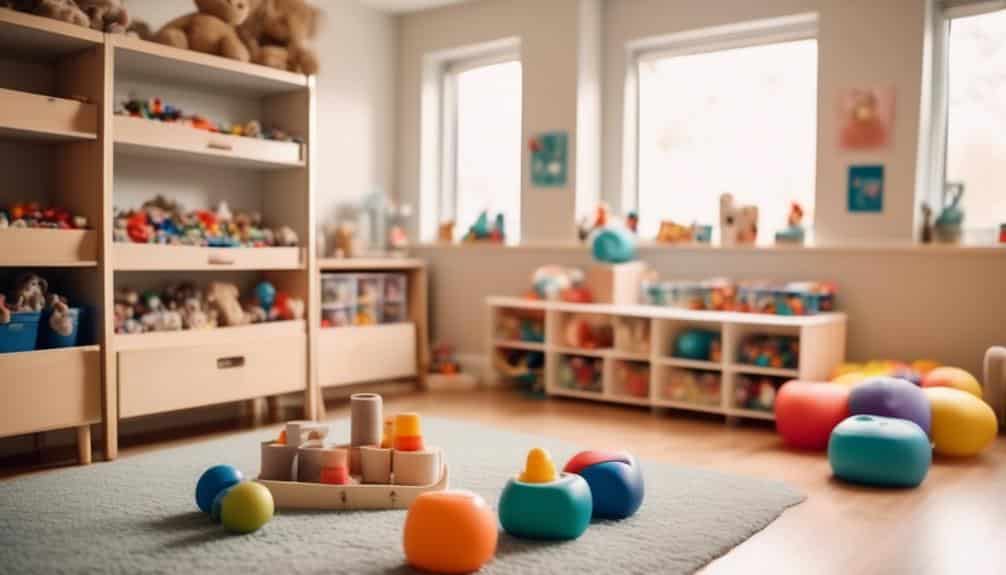Pediatric occupational therapy (OT) is pivotal in enhancing the lives of children with autism and sensory challenges. The nuanced nature of these conditions necessitates a tailored approach, where strategies are carefully adapted to meet the unique needs of each child. Establishing a routine and incorporating sensory activities, as noted in our 14 tips, are merely the starting points for creating an environment conducive to growth and development. From visual aids to the implementation of sensory-friendly spaces, each recommendation is a thread in the intricate tapestry of pediatric OT. As professionals, we must consider how these tips align with current evidence-based practices and interweave with the dynamic fabric of a child’s daily experiences. The subsequent discussion aims to dissect these strategies further, exploring their practical application and the potential impact on a child’s journey toward improved function and independence. Let us begin by examining the foundational elements of sensory integration and its significance in pediatric OT.
Key Takeaways
- Sensory integration is crucial for daily functioning, and occupational therapists play a vital role in assessing and addressing sensory processing abilities.
- Personalized therapy goals and structured environments are essential for promoting improved participation and well-being in children with sensory challenges.
- Sensory diets and nonverbal interaction techniques can empower children to regulate their behaviors and emotions better.
- Developing fine and gross motor skills through therapeutic exercises and play-based activities is essential to sensory integration therapy.
Understanding Sensory Integration
Sensory integration is a critical neurological process wherein the brain coordinates and makes sense of various sensory inputs essential for children to navigate their daily lives quickly and confidently. This intricate process allows for the effective organization and interpretation of sensory information from one’s environment, foundational for everyday functioning and active participation in various activities.
For children with sensory integration difficulties, the challenge to regulate emotions, engage in social interactions, and perform daily routines can be significant. These children may respond to sensory inputs less adaptively, impacting their learning and development. Recognizing these challenges, occupational therapists assess a child’s sensory processing abilities, crafting personalized interventions tailored to each child’s unique needs.
The interventions designed by therapists for sensory integration focus on enhancing the child’s capacity to process and respond to sensory stimuli more effectively. This approach promotes improved participation in daily activities, fostering a sense of accomplishment and well-being. Our empathetic understanding and practical support can make a difference in the lives of these children, empowering them to thrive in their environments.
Autism and Sensory Challenges – Identifying Individual Needs
Each child with autism is unique, presenting distinct sensory preferences and challenges that impact their daily life. Through careful assessment, occupational therapists can discern these individual sensory profiles, enabling the creation of tailored therapy goals. This personalized approach ensures that interventions are focused, practical, and aligned with the child’s developmental needs.
Assessing Sensory Preferences
Understanding a child’s unique responses to various sensory stimuli is critical in crafting tailored therapeutic interventions for those with autism and sensory processing challenges. By assessing sensory preferences, occupational therapists can identify specific needs and develop strategies that facilitate better emotional and self-regulation. Key aspects of this assessment include:
- Observing reactions to stimuli such as light, noise, and textures
- Noting preferences in taste and smell that may affect diet and environment
- Assessing body awareness through proprioceptive and vestibular activities
- Utilizing standardized tools like sensory profiles to document individual sensitivities
Through a compassionate and nuanced approach, therapists can create a supportive and understanding atmosphere that acknowledges each child’s unique sensory landscape, paving the way for more effective and personalized care.
Personalizing Therapy Goals
Building on the foundation of assessing sensory preferences and personalizing therapy goals for children with autism and sensory challenges involves a meticulous process of identifying individual needs to craft targeted treatment plans. Therapists can discern each child’s unique challenges and strengths by conducting comprehensive assessments that evaluate sensory, motor, and cognitive domains. This in-depth understanding enables the creation of concrete therapy goals, ensuring that interventions are tailored to each child’s requirements.
Sensory integration therapy is then employed to process sensory information correctly, promoting a regulated environment conducive to the child’s sensory experiences. Concurrently, activities designed to develop fine and gross motor skills enhance coordination, balance, and planning. Collaboration with parents and caregivers is essential, providing them with the tools and confidence to support their child’s progress and contribute to a team-oriented approach to therapy.
Creating Structured Environments

To support children with autism in navigating their daily lives, establishing a structured environment with clear and consistent schedules is essential for fostering a sense of predictability and security. When children know what to expect, they can better manage their responses and engage more effectively with the world around them.
In creating structured environments, consider integrating the following elements:
- Visual Supports: Utilize visual schedules, picture cues, and visual timers to clarify daily routines and signal transitions, thereby reducing anxiety associated with change.
- Designated Activity Areas: Set aside specific zones for activities such as play, study, and relaxation to establish clear boundaries and aid in organizational skills.
- Sensory Modifications: Introduce sensory-friendly environmental changes, like dimmed lighting or noise-canceling headphones, to minimize sensory overload and help the child remain calm and focused.
- Consistent Routines: Cultivate predictable rituals, such as a bedtime routine or a morning greeting, to give the child a comforting framework to anticipate the flow of their day.
Empathy and practicality guide our approach in crafting environments that respect the unique needs of children with autism, providing them with the stability necessary to thrive.
Incorporating Sensory Diets
A sensory diet, carefully tailored by an occupational therapist, is a personalized activity plan that plays a crucial role in helping children with autism and sensory processing challenges to maintain an optimal state of arousal and focus throughout their day. This strategic approach involves incorporating specific sensory activities that cater to the child’s unique needs, ensuring they are neither overstimulated nor under-stimulated. By doing so, the sensory diet aids self-regulation, allowing the child to engage more successfully with their environment and daily tasks.
Such a diet is not about food but about enriching the child’s day with planned, sensory-rich experiences. These can range from tactile input, like playing with putty, to proprioceptive feedback, such as carrying books. The activities are seamlessly woven into the child’s routine to create a balanced rhythm that supports emotional equilibrium and attention.
Implemented with compassion and understanding, a sensory diet helps minimize stress and prevent burnout, and enhances the child’s ability to adapt and respond to various situations. It empowers them to better recognize their behaviors and emotions, fostering a structured yet flexible approach to meeting their sensory needs. As each child is unique, so is their sensory diet, crafted to provide the foundation for growth and learning.
Enhancing Communication Skills

For children with autism, communication extends beyond words; it’s about fostering connections and understanding. Introducing nonverbal interaction techniques can bridge the gap for those who find verbal communication challenging, offering alternative ways to express themselves and engage with the world. Implementing visual aids like picture schedules can provide clear, consistent cues that enable children to anticipate and participate in daily activities, thereby enhancing their ability to communicate effectively.
Nonverbal Interaction Techniques
Recognizing the pivotal role of nonverbal communication in the lives of children with autism and sensory processing challenges, pediatric occupational therapists often employ various techniques to enhance these vital skills. These techniques are designed to bridge gaps in communication and support the child’s ability to interact with their environment and the people in it. The following are some of the strategies used:
- Visual supports such as picture cards and symbols convey messages without the need for spoken words.
- Sensory-based interventions that provide a calming atmosphere to facilitate focus and engagement during communication attempts.
- Social stories that depict scenarios and model appropriate nonverbal responses and cues.
- Visual schedules establish a predictable routine, reducing anxiety and aiding in comprehending upcoming communicative events.
These tools are empathetically chosen and practically applied to nurture meaningful interactions and empower children with autism to connect with the world around them.
Visual Aids Implementation
Based on nonverbal communication techniques, pediatric occupational therapists integrate visual aids as critical tools to enhance communication skills in children with autism and sensory challenges. By employing visual schedules, therapists help demystify daily routines, easing the stress of transitions. Social stories serve as structured guides to navigate social norms and language use, while visual representations of emotions and self-regulation techniques foster emotional growth. Additionally, visual aids are instrumental in developing joint attention, which is essential for meaningful interactions.
| Visual Aid Type | Purpose |
|---|---|
| Visual Schedules | Simplify daily routines and ease transition-related anxiety |
| Social Stories | Teach social interaction and language in a structured way |
| Emotion Cards | Aid in recognizing and expressing emotions |
| Joint Attention Tools | Enhance shared focus and engagement between child and caregiver |
When used with compassion and expertise, these tools can significantly improve the communicative experience for children with autism and sensory challenges.
Developing Fine Motor Control
To enhance fine motor control in children with autism and sensory challenges, occupational therapists often employ sensory-based strategies and activities tailored to each child’s unique needs. These interventions are crafted to be engaging and therapeutic, aiming to bolster the child’s hand-eye coordination, strength, and agility. It’s essential to approach these activities with patience and understanding, recognizing the diverse ways each child may respond and progress.
Therapists might incorporate a variety of tasks, such as:
- *Therapeutic exercises* involving play dough or putty to strengthen hand muscles.
- *Precision tasks* like stringing beads or placing pegs to promote hand-eye coordination.
- *Functional play-based tasks* that involve everyday objects, like buttoning or sorting, to build mastery.
- *Sensory integration therapy* through textured surfaces or materials to enhance sensory processing and motor control
Building Gross Motor Skills

Enhancing gross motor skills is a critical component of pediatric occupational therapy for children with autism, as it involves activities that improve balance, coordination, and overall movement. Developing these skills is fundamental for children to engage successfully in their daily routines and to participate in play with their peers.
Therapeutic activities are carefully selected to be both enjoyable and beneficial. Obstacle courses, for example, can be designed to challenge a child’s ability to navigate various terrains and heights, which can significantly enhance their spatial awareness and agility. Swings and balance boards are also excellent tools for promoting core strength and equilibrium, essential for gross motor proficiency.
Incorporating games and toys can be particularly effective to support motor development further. These items provide a sense of fun and encourage repetitive practice, which is crucial for skill acquisition. Craft projects involving more significant movements can also contribute to developing gross motor abilities.
Pediatric occupational therapists emphasize play-based learning, recognizing that children are most engaged and likely to develop new skills when having fun. By blending therapeutic goals with play, children with autism can make meaningful progress in building the gross motor skills necessary for a more active and independent life.
Introducing Play-Based Therapy
Play-based therapy is a dynamic and child-centered approach that fosters learning and development within the joy of play. It plays a crucial role in addressing the developmental needs of children with autism and sensory processing challenges, providing a platform for them to explore, discover, and connect. Selecting suitable toys and resources is critical to customizing therapy to each child’s interests and therapeutic goals, ensuring that play remains an effective and enjoyable path to growth.
Benefits of Play Therapy
Understanding the advantages of play therapy is essential, as it offers a dynamic avenue for children, particularly those with autism and sensory processing challenges, to express themselves and learn in a context that is both supportive and engaging. The benefits are multifaceted:
- Encourages self-expression and communication in a joyful, non-threatening setting.
- Fosters meaningful social interaction, nurturing friendships, and collaborative skills.
- Enhances emotional regulation, helping children navigate feelings and develop resilience.
- Promotes independence and confidence through successful, self-directed play experiences.
As professionals dedicated to serving these children, we witness the transformative power of play therapy. It supports their growth in a therapeutic setting and empowers them to transfer these skills to their everyday lives, fostering a sense of achievement and joy.
Selecting Appropriate Toys/Resources
Selecting toys and resources that resonate with the unique needs of children with autism involves thoughtful consideration of their sensory preferences and developmental goals. Sensory play is vital, so consider incorporating textured balls and fidget toys to stimulate touch or sensory bins that allow for exploration. Promote social skills through cooperative games and activities, encouraging turn-taking and fostering mutual engagement. To aid in motor skill development, integrate toys like building blocks and puzzles, and consider swings for gross motor enhancement. Visual supports such as schedules and timers can significantly assist in structure and comprehension during play. Additionally, resources like weighted blankets and noise-canceling headphones can create a calming space essential for those with heightened sensory sensitivities.
Establishing Daily Routines

Establishing daily routines for children with autism and sensory challenges provides stability and security, facilitates smoother transitions, and increases autonomy in their everyday lives. Creating a structured environment with predictable patterns allows these children to navigate their world with less anxiety and more confidence.
To visualize the potential impact of such routines, consider the following elements:
- Consistent Sleep Patterns: Imagine a child waking up and going to bed at the same time each day, their internal clock set, and their body attuned to a rhythm that fosters calmness and focus.
- Visual Schedules: Picture a colorful, easy-to-understand visual schedule that guides the child through their day, providing clear expectations and reducing the stress of unpredictability.
- Sensory Strategies: Envision incorporating sensory breaks, with tools like weighted blankets or fidget toys, seamlessly into the child’s schedule to help manage sensory overloads and maintain equilibrium.
- Step-by-Step Guidance: Think of a child’s empowerment when daily tasks are broken down into small, achievable steps, fostering a sense of accomplishment and self-reliance.
In partnership with parents, occupational therapists can develop individualized strategies, such as a tailored sensory diet, ensuring that each child’s unique needs are met, thus promoting an environment where they can thrive and grow.
Fostering Social Interaction
Building on the foundation of daily routines and fostering social interaction in children with autism and sensory challenges is a pivotal step toward enhancing their communication skills and emotional development. Through pediatric occupational therapy (OT), we can create supportive environments encouraging children to connect with others and navigate social nuances more easily.
| Strategy | Description | Benefits |
|---|---|---|
| Joint Attention Activities | Shared activities like puzzles or simple games to promote eye contact and turn-taking. | Enhances engagement and cooperative play. |
| Social Stories | Stories that depict social situations and appropriate responses. | Teaches social cues and expected behaviors. |
| Visual Schedules | Charts that outline the sequence of activities, aiding in transitions. | Reduces anxiety and supports understanding. |
| Motor Coordination Games | Activities like obstacle courses to improve physical coordination and interaction. | Encourages teamwork and peer interaction. |
Incorporating these strategies, alongside behavior techniques such as positive reinforcement and fading, can significantly improve a child’s ability to engage in meaningful social interactions. Positive reinforcement acknowledges desired behaviors, increasing the likelihood of their recurrence, while fading gradually reduces direct support, promoting independence. Empathetically guiding children through these curated experiences allows them to thrive socially, ultimately serving their connection and community integration needs.
Implementing Behavioral Strategies

Effective implementation of behavioral strategies is essential for fostering positive behavior and enhancing social interaction in children with autism and sensory challenges. With empathy and a dedication to serving these unique children, occupational therapists play a crucial role in promoting their emotional and social development.
Therapists can make a significant impact by focusing on practical and actionable strategies. Consider the following approaches:
- Developing individualized behavior management plans that reinforce positive behaviors and encourage social engagement.
- They teach self-regulation and coping skills to help children manage their emotions and responses to sensory stimuli.
- We are collaborating closely with parents and educators to ensure consistency and effectiveness of behavioral strategies across different environments.
- Modifying surroundings to create sensory-friendly spaces that reduce overstimulation and support the child’s unique sensory needs.
These strategies, rooted in understanding and compassion, aid in the child’s immediate well-being and lay the foundation for long-term growth. As occupational therapists, your role in implementing these behavioral strategies is to craft an environment where children with autism and sensory challenges can thrive, developing the crucial skills they need to navigate the world around them confidently.
Promoting Self-Care Activities
While reinforcing positive behaviors is vital for social development, equally important is fostering autonomy in self-care activities for children with autism and sensory challenges. Such independence can be encouraged by breaking down tasks like brushing teeth or dressing into smaller, manageable steps. This approach simplifies what may seem like a complex activity and builds confidence as each step is mastered.
Visual schedules are a powerful tool in this process. Providing a transparent and predictable structure, they help children understand and anticipate the routine ahead, thereby reducing anxiety and resistance. Tailoring these schedules to each child’s needs can further enhance their effectiveness.
Creating a sensory-friendly environment is another cornerstone of promoting self-care. This means adapting spaces and routines to minimize sensory overload, which can often hinder completing daily tasks. Introducing sensory-based strategies, such as using weighted blankets or playing calming music, can make the environment more conducive to self-care.
Advancing Cognitive Development

How can we best tailor play-based activities to foster the cognitive skills essential for children with autism to thrive in learning, social, and communicative contexts? The approach to advancing cognitive development through occupational therapy should be multifaceted, empathetic, and individualized, capitalizing on each child’s unique interests and capabilities. By carefully designing activities, we can create supportive environments that encourage children to engage, explore, and learn.
Consider the following strategies:
- Utilize puzzles and matching games to enhance problem-solving abilities and visual-spatial reasoning.
- Incorporate role-playing or pretend play to develop planning, flexibility, and perspective-taking skills.
- Design obstacle courses or treasure hunts that require sequencing, memory recall, and attention to detail.
- Use technology, such as tablet-based applications, to reinforce cognitive concepts in an interactive and motivating format.
When selecting these activities, it’s crucial to be sensitive to each child’s sensory preferences and to modify tasks to align with their developmental stage. We can bolster their confidence and willingness to engage in new cognitive challenges by fostering a sense of achievement and autonomy. Through attentive and compassionate guidance, we empower autistic children to build a robust foundation for lifelong learning and meaningful social connections.
Collaborating With Families
Building on the foundation of tailored play-based activities, successful pediatric occupational therapy for autism also hinges on a solid partnership with the child’s family. Therapists must establish open and regular communication channels with families to understand the child’s unique needs and goals deeply. Involvement of the family in the goal-setting process ensures that therapy objectives are clinically relevant and resonate with the family’s priorities and values.
| Strategies for Collaboration | Family Involvement | Expected Outcomes |
|---|---|---|
| Regular Communication | Share Insights | Tailored Therapy |
| Joint Goal-Setting | Align Objectives | Meaningful Progress |
| Home-Based Support | Apply Techniques | Consistent Growth |
| Education & Training | Empowerment | Enhanced Skills |
Frequently Asked Questions
What Are the OT Interventions for Autism?
Occupational therapy interventions for autism typically include sensory integration therapy, social skills training, daily living activities, motor development exercises, and individualized behavioral strategies to enhance overall functioning and independence.
What Are Coping Strategies for Autistic Children?
While some may question their efficacy, coping strategies such as visual schedules, sensory integration therapy, structured social stories, and joint attention activities have proven beneficial for autistic children in managing daily challenges.
How Do You Discipline an Autistic Child for Not Listening
When disciplining an autistic child for not listening, it’s crucial to employ clear communication, consistent consequences, and positive reinforcement while considering the child’s unique sensory and communication needs for effective behavior management.
Will My 7-Year-Old Autistic Child Ever Talk?
Many autistic children develop communication skills with time and tailored therapy. Progress and prognosis vary, so a continued partnership with healthcare professionals is pivotal for your child’s potential speech and language gains.
Conclusion
Pediatric occupational therapy is a valuable tool for children with autism spectrum disorder to develop essential life skills. Therapists play a crucial role in helping children with sensory difficulties overcome challenges in their daily lives. Using sensory integration approaches, these health professionals can support children in regulating their arousal levels and developing sensory processing skills.
Occupational therapists create individualized treatment plans that address the unique needs of each child. These plans may include sensory activities, therapeutic activities, and functional skills training. The therapist may use tools like sensory bottles, social stories, and quiet spaces to help the child learn at their own pace and comfort level.
Sensory integration therapy is a common intervention for children with an autism spectrum disorder. This type of therapy helps children develop motor skills, hand-eye coordination, and spatial awareness. It also allows them to improve their body awareness and body language. By providing a controlled environment, therapists can help children overcome sensory sensitivities and experience a variety of sensory inputs.
Speech therapy, behavior therapy, and cognitive-behavioral therapy are other interventions for children with autism. These therapies focus on developing communication, problem-solving, and social communication skills. Parents of children with autism spectrum disorder can work with therapists to create a practical guide for daily living skills.
Sensory processing challenges are a common issue for individuals with autism spectrum disorder. Oversensitive children may experience sensory overload, while undersensitive children may seek out sensory stimulation. Proprioceptive activities, tactile stimulation, and sensory experiences can help individuals with autism regulate their anxiety levels and develop adaptive behavior.
According to the American Journal of Occupational Therapy, the potential of individuals with autism can be unlocked with a holistic approach. This approach considers all aspects of life and provides therapy tailored to the individual’s developmental level and physical health. By using sensory integration therapy, therapists can help individuals with autism develop skills that will benefit them throughout their therapy journey.


Recent Comments